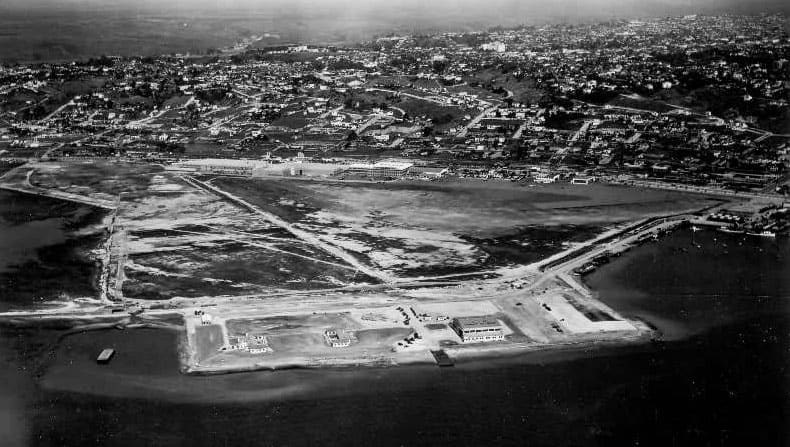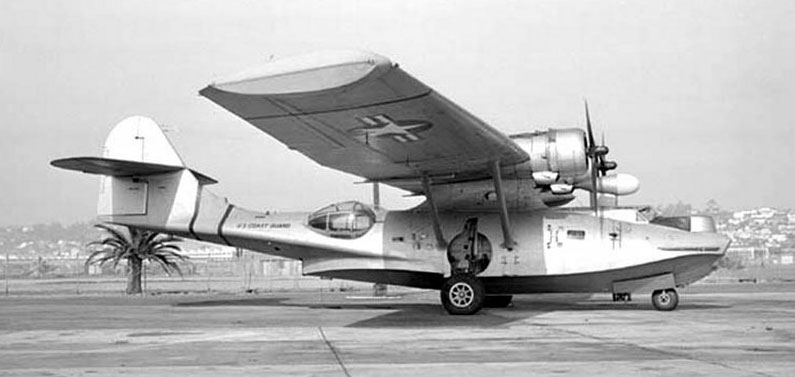
San Diego Lindberg Field opened on August 16, 1928. Coast Guard aviation activities in the San Diego, California area began as an Air Patrol Detachment on May 4, 1934 for the purpose of preventing smuggling across the Mexican Border. The Detachment operated from a commercial hangar on the airport. The mission soon expanded to include the saving of life and property. In December of 1935 negotiations between the City of San Diego and the U.S. Government were concluded which provided 23 acres of tideland for the construction of a Coast Guard air station adjacent to Lindbergh Field. This project had the strong support of many people and agencies, and particularly the Harbor Commission, the San Diego Municipal Government and the Chamber of Commerce. The area for this station was deeded to the Coast Guard at no cost after approval by the citizens of San Diego at a municipal election held in April of 1935.
Construction of the Air Station was undertaken in 1936 with funds provided by the Federal Public Works Administration. The M.H. Golden Co. was the contractor. The area was filled and brought up to grade level by dredging from the bay. Long piles were driven in the soil at the building sites for stabilization. The contract called for one hangar with a lean-to, a mess hall, a barracks building, two aprons, a runway to the field, and a small wooden seaplane ramp. During construction the Air Patrol Detachment continued to operate out of Lindbergh Field. In April of 1937 Coast Guard Air Station San Diego was commissioned.
A RD-4 and an additional JF-2 were the initial station aircraft. Two Hall seaplanes, a PH-2 and a PH-3 were added later. The search and rescue mission continued to grow and a JF-2 was deployed on a regular basis to Oakland, California as a sub-unit at the Naval Reserve Base. From there it effectively performed search and rescue operations in the San Francisco Bay area.
With the declaration of war in 1941 unit aircraft commenced anti-submarine patrols but the threat of Japanese submarines off the Pacific Coast proved to be minimal. The unit continued to watch and report the activities of vessels in the area, to provide assistance in cases of distress, and to provide transportation by air for other government departments. A rapid expansion of military aviation took place during the war which produced an increasing number of offshore crashes, mostly by student pilots, with the inherent loss of life. The Commander of the 11th Naval District became very concerned about the situation. CDR Watson Burton, commanding the San Diego Air station recommended the formation of a squadron designed for rescue operations. Coast Guard Air-Sea Rescue Squadron 1 was formed in 1943. PBY-5A aircraft were provided.

Air Sea Rescue operations became the primary focus from October 1943 on. Between January 1 and December 1, 1944, a total of 124 aircraft went down in waters covered by this squadron. Of the 201 pilots and crewmen involved, 137 were saved, 59 were killed outright by mid-air collisions or impact with the water, two are missing, and three who might have been saved were lost because of improper equipment.
Air Sea Rescue operations became the primary focus from October 1943 on. Between January 1 and December 1, 1944, a total of 124 aircraft went down in waters covered by this squadron. Of the 201 pilots and crewmen involved, 137 were saved, 59 were killed outright by mid-air collisions or impact with the water, two are missing, and three who might have been saved were lost because of improper equipment.
Air Sea Rescue continued to be the primary mission after the war and the PBYs were replaced by Martin PBM-5G aircraft. A PBM was used by CAPT D.B. MacDiarmid at Air Station San Diego to evaluate techniques and procedures for open sea landings. Landings in the open sea were never safe but his findings made them safer. Helicopters arrived at San Diego in the 1950s and greatly increased rescue capabilities. The station kept pace with the development of Coast HH-3F – Approaching CGAS San Diego 1Guard aviation and remained vital to the performance of Coast Guard missions. Over the next 60 years the PBMs/P5Ms were replaced by the HU-16. This was in turn replaced by the HU-25. The HO4S helicopters were replaced by the HH52A, HH-3F and then the HH60J; each aircraft type fulfilling the assigned missions.
With the expansion of the Coast Guard mission all operational units in the San Diego area were combined into one command called Coast Guard Sector San Diego.
The Air Station is physically separated from the rest of the airport which required USCG fixed-wing aircraft to cross North Harbor Drive. This was a common occurrence until recently when CGAS became a HH-60J unit.
